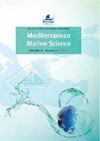The deep vault: a temporary refuge for temperate gorgonian forests facing marine heat waves
IF 2.3
3区 环境科学与生态学
Q1 MARINE & FRESHWATER BIOLOGY
引用次数: 0
Abstract
Climate change poses a significant threat to coastal areas, marked by the increasing intensity and frequency of marine heat waves observed in various ecosystems around the world. Over the last 25 years, a vast number of Mediterranean populations of the red gorgonian Paramuricea clavata have been impacted by marine heatwaves. The last mass mortality occurred during the summer of 2022 in the Western Mediterranean Sea, affecting mostly shallow populations (down to 30 m depth). Here we provide an assessment of the health status of mesophotic P. clavata populations down to 90 m depth to investigate a depth refuge hypothesis. Results show that the impact of marine heat waves decreases with depth, with a significant drop in mortality below 40 m depth. These observations support the hypothesis of a depth refuge from marine heat waves that may allow, at least temporarily, the maintenance of P. clavata in the Western Mediterranean Sea. The present study strongly advocates for further investigations and monitoring of the mesophotic zone to chart potential areas that could serve as deep refuge for gorgonians.深穹:温带海棠林面对海洋热浪时的临时避难所
气候变化对沿海地区构成了重大威胁,在全球各种生态系统中观察到的海洋热浪的强度和频率都在不断增加。在过去的 25 年里,地中海地区的大量红芡实(Paramuricea clavata)种群都受到了海洋热浪的影响。最近一次大规模死亡发生在 2022 年夏季的西地中海,受影响的主要是浅海种群(最深 30 米)。在此,我们评估了水深达 90 米的中浅海 P. clavata 种群的健康状况,以研究深度避难所假说。结果表明,海洋热浪的影响随着深度的增加而减小,深度低于 40 米时死亡率显著下降。这些观察结果支持海洋热浪深度避难所的假说,该避难所至少可以暂时维持西地中海中 P. clavata 的生存。本研究强烈建议进一步调查和监测中深海区,以绘制可作为蛙龙鱼深海避难所的潜在区域图。
本文章由计算机程序翻译,如有差异,请以英文原文为准。
求助全文
约1分钟内获得全文
求助全文
来源期刊

Mediterranean Marine Science
MARINE & FRESHWATER BIOLOGY-
CiteScore
5.20
自引率
17.90%
发文量
34
审稿时长
>12 weeks
期刊介绍:
The journal Mediterranean Marine Science (MMS), published by the Hellenic Centre for Marine Research (HCMR), issues three volumes annually. The journal welcomes original research articles, short communications, New Mediterranean Biodiversity records, extended reviews, comments, and Theme sections in all fields of Oceanography, Marine Biology, Marine Conservation, Fisheries and Aquaculture in the Mediterranean area and the adjacent regions. All content is peer reviewed.
 求助内容:
求助内容: 应助结果提醒方式:
应助结果提醒方式:


